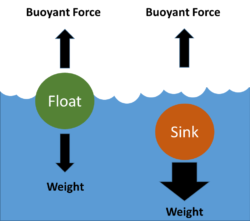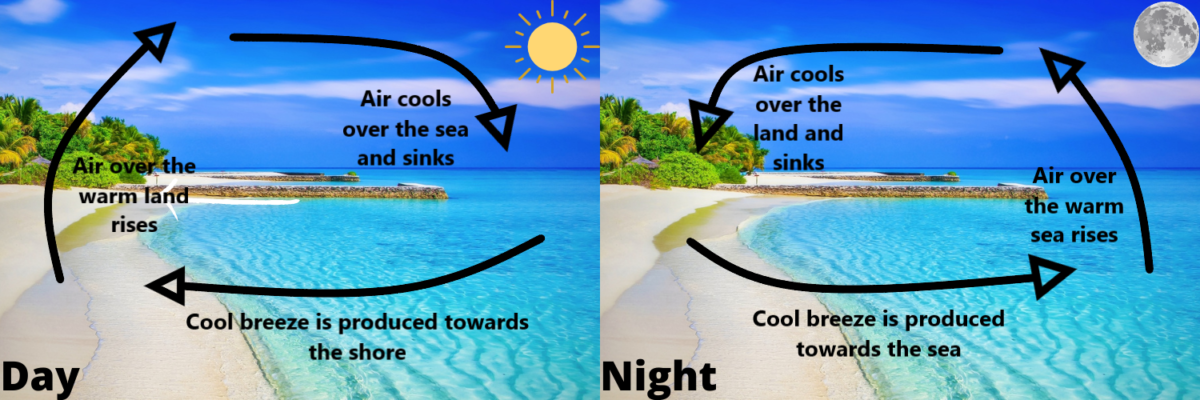Density
Author: Yatin Darbar
Why, when you toss a coin into a fountain does it sink to the bottom of the water, yet when you throw a piece of bread in a pond to feed the ducks it floats on the surface? What causes the cool inland and outland sea breezes? And why does opening the front door of a house when the heating has been on “let all the heat out”?
These are all phenomena that can be attributed to density. To answer these questions first we must understand what density is, and then how it influences fluid behaviour.
The density of an object or substance is its mass divided by its volume.
Density=Mass/Volume.
More intuitively, density is a measure of the amount of “stuff” in an object or substance. Here “stuff” is a non-scientific term for molecules, particles, elements, atoms, and all things that make up the material world. As an example, salt water is more dense than pure water, since is contains heavier molecules within any given volume.
Density influences many things in everyday life and we can use our understanding of density to explain these processes.
Sinking and Floating

When an object is placed in a fluid, such as water, there are two dominant forces acting on the object. Firstly, the water exerts a buoyant force on the object which pushes it upwards, towards the water’s surface. Secondly the weight of the object also acts to pull it down through the water.
Both these opposing forces are dependent on the density; hence the density of an object determines whether it will sink or float. If the density of the object is greater than the density of the fluid then the object will sink, this is the case for coins in a fountain. However, if the density of the object is smaller than the fluid, then the object will float. Hence why pieces of bread float on the water’s surface since bread is less dense than water.
The same thing is true for fluids on top of fluids too! If a denser fluid, such as water, is put on top of a less dense fluid, such as oil, it will sink through the water creating two distinct layers of fluid. This multiple fluid-layering phenonemon is shown in a video.

The movement of water and oil is a simple example of how density differences cause fluids to flow. A real-world example of this is land and sea breezes.
Convection – Land & Sea breezes
Interestingly the density of a fluid is not fixed like for many solid objects. It can change under certain conditions. The most common factor that can change a fluids density is temperature. When a fluid is heated it expands and become less dense. Since less dense fluids are more buoyant, they will move vertically upwards causing convection flows. These flows are important to understanding flows in the atmosphere and the ocean.
One such example of convection flows are land and sea breezes. In coastal regions, two distinct breezes occur – land breezes and sea breezes. Sea breezes occur during daytime and are a cool wind that originates from the sea towards the land, whereas land breezes occur during the night and are a cool wind from the land towards the sea. These two breezes are caused by the different heating effects which occur over land and water.
During the day, the land heats up quite quickly from the sun. This causes the air above the land to warm up, therefore becoming less dense so it rises. At the same time the cool air over the water which is denser rushes into the fill the place of the warm rising air. Hence a cool breeze blows from the sea inland.

However, during the night the land loses heat quickly, while the sea retains its warmth, and the whole process is reversed. Air over the sea is now heated, therefore becoming less dense and rising, with the cool air from the land now rushing in to replace the rising air. Hence a cool breeze flows from the land out towards the sea.
When fluids move due to changes in density, we call these movements density or gravity currents. When you open your front door and the cold air rushes in, and the warm air rushes out, this is also a density current like the sea and land breezes. The flow of air cause by the density current is why we experience a cool draft around our legs when we stand by the open door, because the cold dense air flows along the floor.
In the following video, food dye has made it possible for us to see a gravity current as it flows. Here, the density difference is caused by adding salt to the green water, which is denser than the fresh water in the rest of the tank, and so the saltwater flows along the bottom of the tank once the lock-gate is removed.
Can you think of other flows caused by density differences?
Video of gravity current demonstration.
